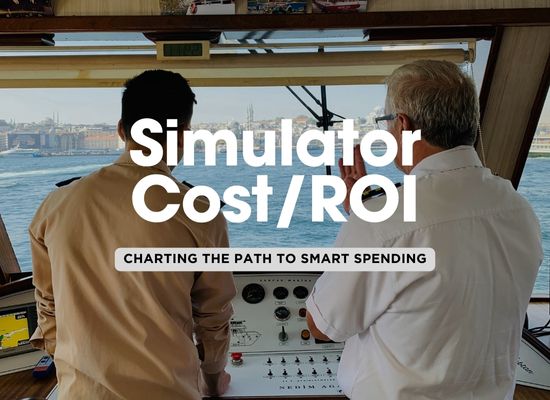Ship Training Simulators – Cost-Benefit Analysis

Marine training simulators are revolutionizing the way mariners train, offering a safer, cost-effective, and highly immersive alternative to traditional on-board training. These state-of-the-art systems recreate real-world maritime environments, allowing crew members to master critical skills before ever setting foot on a ship. But do these simulators deliver a solid return on investment (ROI) for maritime businesses? Let's dive in!
Table of Contents
Types of Marine Training Simulators
Why Marine Simulators Are a Game-Changer
Breaking Down the Costs of Marine Training Simulators
Sample Budget for a Maritime Training Simulator
How to Measure ROI on Marine Training Simulators
Have questions or feedback? Reach out to editor at shipuniverse.com
🔴 Free Service: We can help you find the right simulator at the right price—no cost, no hassle.
⚓️ Types of Marine Training Simulators
Not all simulators are the same. Different roles on a ship require different training environments. Here are the most common types of simulators, each tailored to a specific function:
1️⃣ Bridge Simulators
The heart of ship navigation. Bridge simulators replicate the environment of a ship’s command center, complete with control panels, steering systems, radar, and Electronic Chart Display and Information Systems (ECDIS). Crew members can practice navigation, route planning, and emergency response.
Key Features:
- Replicates ship navigation and maneuvering
- Hands-on experience with real-time decision-making
- Used to train captains, deck officers, and navigational crew
Example Uses:
- Navigating narrow channels
- Handling emergency maneuvers in rough seas
- Simulating high-traffic areas like ports and straits
2️⃣ Engine Room Simulators
The ship’s "powerhouse" — this is where engineers learn how to keep the engines running smoothly. Engine room simulators teach technical crew how to operate, maintain, and troubleshoot ship engines.
Key Features:
- Realistic replication of engine components
- Covers key systems like fuel, lubrication, and propulsion
- Used to train marine engineers and engine room staff
Example Uses:
- Diagnosing and repairing engine failures
- Learning to handle power blackouts or system overloads
- Practicing maintenance routines for propulsion and auxiliary systems
3️⃣ Full Mission Simulators
Full mission simulators combine bridge, engine room, and emergency response into one comprehensive training experience. This "all-in-one" approach prepares mariners for a complete range of shipboard operations.
Key Features:
- Combines navigation, engine control, and safety procedures
- Simulates emergencies, crew coordination, and crisis response
- Used for senior crew and multi-role training (captains, engineers, and officers)
Example Uses:
- Ship evacuation drills
- Firefighting and emergency response exercises
- Simulating onboard coordination between departments
4️⃣ Cargo Handling Simulators
Specialized simulators for training crew in the safe handling of bulk cargo, containers, or hazardous materials. These simulators focus on crane operations, stability management, and cargo loading procedures.
Key Features:
- Models ship stability during cargo loading/unloading
- Trains crane operators, stevedores, and dockworkers
- Reduces risk of damage to cargo and ensures compliance with safety protocols
Example Uses:
- Training crane operators on how to stack containers safely
- Teaching ship officers how to calculate cargo stability
- Practicing loading/unloading hazardous materials under strict safety protocols
5️⃣ Liquid Cargo Simulators
Liquid cargo handling requires specialized training since it involves hazardous, volatile, or temperature-sensitive cargo. Liquid cargo simulators replicate the environment of a tanker ship, allowing crew to master the complexities of loading, discharging, and managing ballast.
Key Features:
- Focus on tanker cargo (oil, LNG, chemicals, etc.)
- Simulates ballast water control and cargo heating/cooling
- Used to train tanker crew, including chief officers and terminal operators
Example Uses:
- Managing the loading of liquid natural gas (LNG)
- Controlling ballast water and managing ship stability
- Training crew on compliance with MARPOL ballast regulations
📘 Why Marine Simulators Are a Game-Changer
Training on a live ship is expensive, time-consuming, and sometimes unsafe. Simulators solve this problem by offering a "safe sandbox" where crew members can make mistakes without real-world consequences. Here’s why that matters:
1️⃣ Real Skills in a Risk-Free Environment
Instead of learning on a ship (where mistakes can be costly), mariners train in a controlled, fail-safe environment. Simulators allow crew to repeat scenarios until they get them right.
2️⃣ Hands-On Practice Without Danger
Crew can experience dangerous situations—like engine failures, blackouts, or fires—without being at risk. This means better preparedness when things go wrong at sea.
3️⃣ Custom Scenarios
Simulators allow trainers to create specific scenarios. Need to practice navigating the Panama Canal or simulate a collision with a rogue ship? No problem.
4️⃣ Cost-Saving
Simulators reduce the need for on-board training, minimizing fuel, labor, and operational costs. They also reduce the risk of human error.
Breaking Down the Costs of Marine Training Simulators
Thinking of investing in a simulator? Here’s a clear look at the costs:
1️⃣ Hardware
You’ll need screens, control panels, joysticks, and bridge consoles. For cargo simulators, add cranes and load stability systems.
Estimated Cost: $25,000 - $75,000
2️⃣ Software Licenses
This includes the navigation systems, ship models, and training scenarios. Licensing fees are usually billed annually.
Estimated Cost: $10,000 - $30,000 annually
3️⃣ Installation & Setup
Once you buy the hardware and software, you’ll need technicians to install and calibrate everything.
Estimated Cost: $5,000 - $15,000
4️⃣ Training for Trainers
Your staff needs to know how to use the simulator, create scenarios, and troubleshoot problems.
Estimated Cost: $5,000 - $15,000
5️⃣ Facility Setup
This covers electricity, HVAC, and physical space to house the simulator.
Estimated Cost: $10,000 - $30,000
6️⃣ Ongoing Maintenance
Simulators need constant software updates, hardware repairs, and replacement of worn components.
Estimated Cost: $7,500 - $20,000 annually
7️⃣ Insurance & Compliance
You may need insurance coverage for the equipment itself as well as regulatory compliance.
Estimated Cost: $3,000 - $7,500 annually
⚓️ Save Time, Money, and Hassle – Request Simulator Quotes Today
Sample Budget for a Maritime Training Simulator
** Costs can vary greatly but this should give you a general idea.
| ShipUniverse: Maritime Training Simulator Budget | ||
|---|---|---|
| Expense Category | Description | Estimated Cost (USD) |
| Hardware Costs | Simulator consoles, monitors, control panels, VR headsets (if applicable) | $25,000 - $75,000 |
| Software Licenses | Navigation software, 3D ship models, simulation software | $10,000 - $30,000 annually |
| System Integration | Setup, calibration, and system integration of hardware and software | $5,000 - $15,000 |
| Facility Setup | Space preparation, power supply, ventilation, and furniture | $10,000 - $30,000 |
| Training and Onboarding | Training for operators, instructors, and support staff | $5,000 - $15,000 |
| Staff Salaries | Simulator operators, technicians, and support staff | $50,000 - $100,000 annually |
| Maintenance & Support | Ongoing maintenance, software updates, and technical support | $7,500 - $20,000 annually |
| Insurance & Compliance | Liability insurance and certification compliance | $3,000 - $7,500 annually |
| Contingency | Allowance for unexpected costs and emergency repairs | $5,000 - $10,000 |
| Utilities & Overheads | Electricity, internet, water, and HVAC system | $3,000 - $10,000 annually |
| Total Estimated Cost | (Initial setup + 1st year operational costs) | $125,000 - $320,000 |
The Full Picture: Why Marine Training Simulators Are Worth It
Marine training simulators are an investment, and like any major purchase, it's important to understand where your money is going. The wide range in costs reflects the diverse options available, from basic setups to cutting-edge, full-mission simulators. With so many choices, finding the right fit at the right price can be challenging, but expert guidance can make the process much easier. While the upfront price may seem steep, the long-term returns in training quality, safety, and operational efficiency can far exceed the initial expense.
💪 Skills Without Risk
Simulators allow mariners to train for high-stakes situations in a completely safe environment. Crews can practice navigating in stormy weather or handling critical engine failures—without risking damage to a vessel. This type of training is as close to "the real thing" as it gets, and the ability to practice repeatedly makes it invaluable.
🛡️ Safer Crews, Safer Seas
When crews are better prepared to handle emergencies, the risk of maritime incidents is significantly reduced. Fewer accidents mean fewer insurance claims, less downtime, and a safer work environment for everyone on board. In an industry where safety is paramount, the value of a well-trained crew is immeasurable.
💸 The Financial Payoff: Why Simulators Save You Money
1️⃣ Fewer Costly Mistakes
Every maritime accident has a ripple effect—ship damage, environmental fines, insurance hikes, and legal fees. A single incident can cost millions. Simulators give crews the chance to learn from mistakes without causing real-world damage, ultimately reducing the likelihood of costly errors at sea.
2️⃣ Boosted Efficiency
Crews trained on simulators tend to be quicker, more precise, and better equipped to manage high-pressure situations. From faster docking to improved equipment handling, their efficiency can directly translate to lower operational costs.
3️⃣ Long-Term Ripple Effects
Simulators have long-term benefits that extend beyond a single voyage. Safer seas mean fewer disruptions to the supply chain, smoother shipping operations, and better compliance with maritime regulations.
📊 How to Measure ROI on Marine Training Simulators
Investing in a marine training simulator isn't just about counting dollars—it's about long-term impact. Here’s how you can evaluate the return on your investment (ROI).
💰 Tangible ROI (The Easy Stuff)
These are the direct, trackable savings:
- Accident Reduction: Fewer mishaps mean less money spent on repairs, legal fees, and insurance premiums.
- Lower Training Costs: No need to send crew members out to sea for hands-on experience. They can train onshore.
- Reduced Insurance Premiums: Some insurers offer lower premiums for companies with advanced crew training programs.
💡 Intangible ROI (The Hidden Value)
These are the benefits that are harder to quantify but just as important:
- Crew Confidence & Retention: Confident crews stick around longer. A well-trained crew is also less likely to jump ship (literally and figuratively) for another employer.
- Operational Efficiency: Crews who’ve trained on simulators react faster and make better decisions during emergencies, resulting in more efficient operations.
- Brand Reputation: Companies with better safety records are seen as more reliable by clients, insurers, and regulatory authorities.
🧭 Making the Call: Is It Worth It?
Marine training simulators aren’t just a purchase—they’re a strategic investment in the future of maritime safety and efficiency. While the initial cost may seem substantial, it’s essential to look beyond the price tag. Consider the ripple effects: fewer accidents, better-trained crews, improved operational efficiency, and long-term financial savings.
When done right, this investment isn't just about better training—it’s about building a safer, smarter, and more cost-effective maritime operation. And in an industry where the stakes are high, that peace of mind is worth every penny.
⚓️ Find Your Perfect Maritime Simulator – We Handle the Heavy Lifting!
Maritime Training Simulator Suppliers
- VSTEP - Specializing in simulation technology, VSTEP offers the NAUTIS range of maritime simulators for various training needs, known for their realism and flexibility. Visit VSTEP
- Kongsberg Maritime - A global leader in maritime technology, Kongsberg Maritime provides high-quality simulators for navigation, engine control, and safety training, widely used in maritime academies and training centers. Visit Kongsberg Maritime
- Transas (Wärtsilä Voyage) - Known for their integrated bridge systems and simulation solutions, Transas, now part of Wärtsilä Voyage, offers a wide range of maritime simulators for navigation, ship handling, and communication training. Visit Transas
- CM Labs Simulations - They offer simulation-based solutions to improve training and mission rehearsal, with a focus on maritime applications including ship handling and port operations. Visit CM Labs Simulations
- Marine Learning Systems - Known for their e-learning and simulation-based training solutions, they focus on operational and safety training for the maritime industry. Visit Marine Learning Systems
- 7Seas Maritime - Offering a range of simulation-based training solutions, 7Seas Maritime provides simulators for navigation, ship handling, and engine operations, catering to both maritime academies and individual companies. Visit 7Seas Maritime
- Buffalo Computer Graphics (BCG) - BCG provides maritime training solutions, including navigation and communication simulators, widely used by maritime schools and government agencies. Visit Buffalo Computer Graphics
- NAVTOR - Known for their digital navigation solutions, NAVTOR also offers simulation technology for maritime training, emphasizing ease of use and integration with other navigational tools. Visit NAVTOR
- Simwave - Specializes in customized maritime simulation solutions, offering a broad range of training options for various maritime disciplines. Visit Simwave
- Aboa Mare - A maritime academy and training center, Aboa Mare offers a wide range of simulators for navigation, engine room, and other specialized maritime training. Visit Aboa Mare

Do you have a Maritime Product or Service that may be of interest to Shipowners? Tell us about it here!
Do you have feedback or insights? Please reach out to editor @ shipuniverse.com



